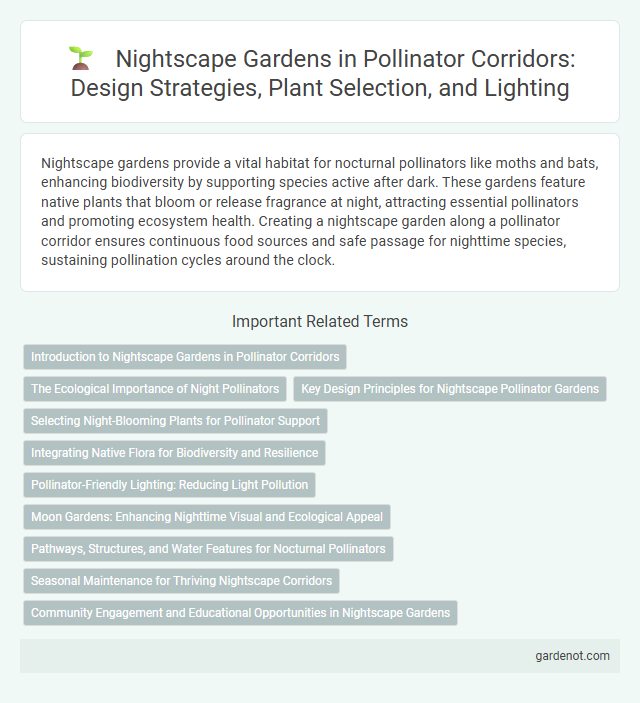Nightscape gardens provide a vital habitat for nocturnal pollinators like moths and bats, enhancing biodiversity by supporting species active after dark. These gardens feature native plants that bloom or release fragrance at night, attracting essential pollinators and promoting ecosystem health. Creating a nightscape garden along a pollinator corridor ensures continuous food sources and safe passage for nighttime species, sustaining pollination cycles around the clock.
Introduction to Nightscape Gardens in Pollinator Corridors
Nightscape gardens in pollinator corridors create nocturnal habitats rich with night-blooming flowers and native plants that attract moths, bats, and other night-active pollinators. These gardens enhance biodiversity by providing essential resources such as nectar and shelter during nighttime hours, extending the foraging opportunities beyond daylight. Integrating nightscape gardens into pollinator corridors supports ecosystem resilience, promoting pollination services critical for both wild flora and agricultural crops.
The Ecological Importance of Night Pollinators
Nightscape gardens provide essential habitats for nocturnal pollinators such as moths, bats, and certain beetles, which play a critical role in pollinating plants that bloom or release fragrance at night. These pollinators contribute to biodiversity by facilitating the reproduction of night-adapted flowers, supporting ecosystem resilience and food webs. Preserving and designing nightscape gardens enhances the survival of these species, promoting balanced pollination cycles beyond daylight hours.
Key Design Principles for Nightscape Pollinator Gardens
Nightscape pollinator gardens prioritize the use of native nocturnal-flowering plants to attract moths, bats, and other night pollinators crucial for ecosystem health. Design incorporates low-intensity, warm-hued lighting that minimizes light pollution and preserves natural night conditions, supporting nocturnal wildlife behavior. Creating layered vegetation structures enhances habitat diversity, offering food and shelter to a variety of night-active pollinating species.
Selecting Night-Blooming Plants for Pollinator Support
Selecting night-blooming plants such as moonflowers, evening primrose, and night-blooming jasmine enhances a Nightscape garden's role in supporting nocturnal pollinators like moths, bats, and beetles. These plants release strong fragrances and produce nectar during nighttime hours, attracting essential pollinators that contribute to ecosystem health and biodiversity. Incorporating native species with high nectar content further maximizes pollinator visitation and promotes sustainable nocturnal pollination corridors.
Integrating Native Flora for Biodiversity and Resilience
Nightscape Garden incorporates native flora such as milkweed, goldenrod, and bee balm to establish a pollinator corridor that enhances biodiversity and ecosystem resilience. These indigenous plants provide essential nectar and habitat for native pollinators like monarch butterflies, bumblebees, and solitary bees, supporting their life cycles. Integrating native species within the garden promotes soil health, water retention, and climate adaptability, strengthening overall ecological stability.
Pollinator-Friendly Lighting: Reducing Light Pollution
Nightscape garden integrates pollinator-friendly lighting designed to minimize light pollution and preserve nocturnal insect activity critical for pollination. Utilizing amber and low-intensity LED lights, this garden ensures minimal disruption to moths, bats, and other night pollinators' natural behaviors. Strategic light placement enhances habitat connectivity within pollinator corridors, supporting biodiversity and ecological health.
Moon Gardens: Enhancing Nighttime Visual and Ecological Appeal
Moon Gardens in Nightscape designs enhance nighttime visual appeal by featuring white and pale-colored flowers that reflect moonlight, creating a luminous landscape. These gardens support nocturnal pollinators such as moths and bats by providing nectar and habitat during nighttime hours. Incorporating native, night-blooming plants like evening primrose and night phlox optimizes ecological benefits within pollinator corridors.
Pathways, Structures, and Water Features for Nocturnal Pollinators
Nightscape gardens enhance pollinator corridors by incorporating winding pathways that minimize light pollution, allowing nocturnal pollinators like moths and bats to navigate easily. Structural elements such as bat boxes and low-profile shelters provide essential roosting and resting sites, increasing habitat diversity within urban green spaces. Water features designed with gentle lighting and shallow edges supply hydration without disrupting the nighttime activity of critical pollinator species.
Seasonal Maintenance for Thriving Nightscape Corridors
Seasonal maintenance in Nightscape gardens involves strategic pruning, planting native nocturnal-flowering species, and managing light pollution to enhance habitat quality for night-active pollinators such as moths and bats. Regular soil enrichment and removal of invasive plants support the continuous bloom cycles critical for sustaining a thriving pollinator corridor throughout the year. Implementing adaptive watering schedules aligned with seasonal climate variations ensures optimal plant health and resource availability for nocturnal pollinator species.
Community Engagement and Educational Opportunities in Nightscape Gardens
Nightscape gardens serve as vibrant pollinator corridors that actively engage communities through workshops and guided nocturnal tours, fostering awareness about native pollinators' crucial roles in local ecosystems. These gardens provide educational opportunities by hosting citizen science programs and interactive exhibits that demonstrate pollination processes and biodiversity conservation. By connecting people with nighttime ecology, nightscape gardens cultivate stewardship and inspire sustainable gardening practices supporting pollinator health.
Nightscape garden Infographic

 gardenot.com
gardenot.com